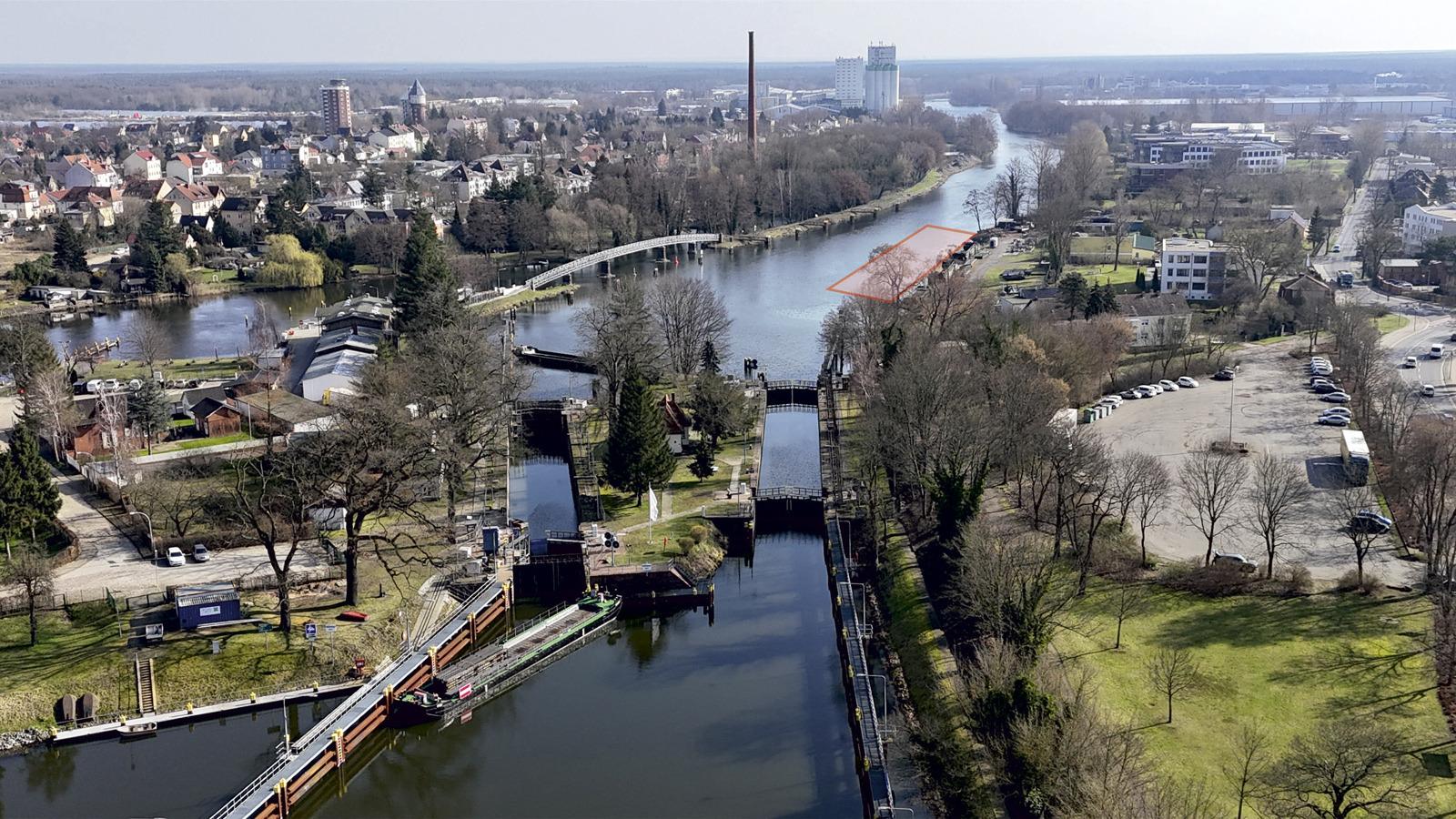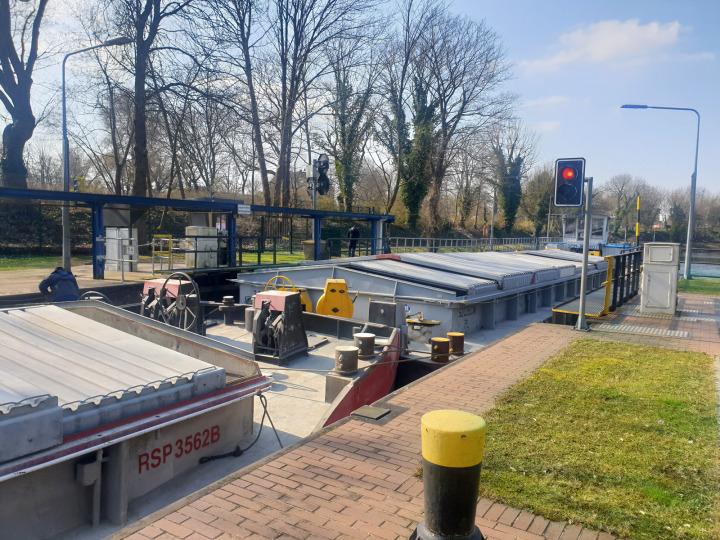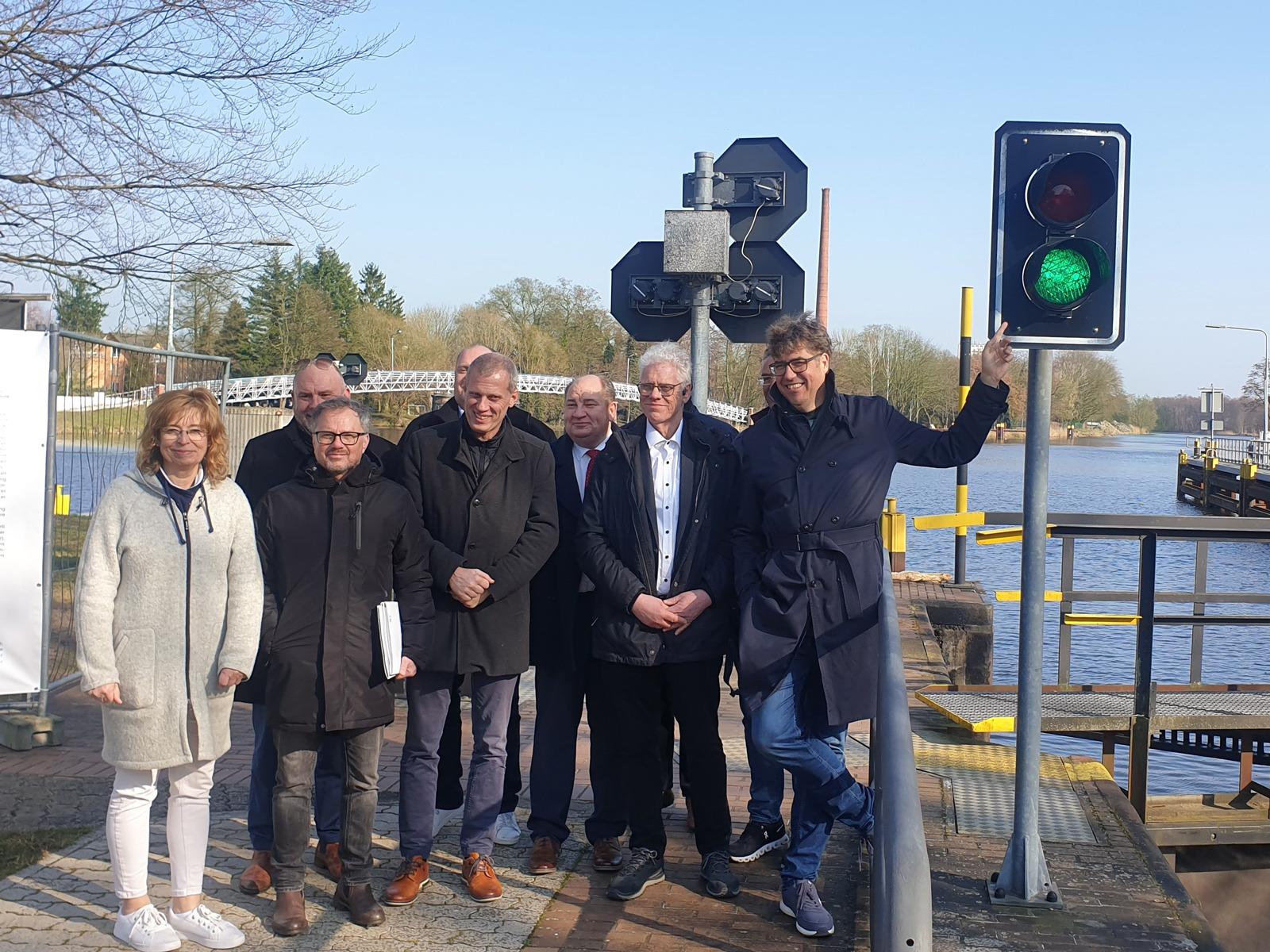
The dawn of a new era of inland shipping on the Oder-Spree Canal
At the invitation of Michael Kellner (Member of the Bundestag and PStS in the BMWK) and Erdmute Scheufele (Member of the Oder-Spree District Council), a press event was held on 7 March 2024 at the Fürstenwalde lock. On March 7, 2024, a press event was held at the Fürstenwalde lock with an alliance of local shippers, shipping companies and port operators as well as the East Brandenburg Chamber of Industry and Commerce to usher in a new era of inland shipping on the Oder-Spree Canal
It was announced that the BMDV has now decided to replace the lock chambers at the Fürstenwalde barrage, which date back to 1891 and 1914, with a new, future-proof replacement lock chamber with a usable length of 115 meters.
Oliver Luksic (MdB) as PStS in the BMDV: "The decision taken in the BMDV to replace the Fürstenwalde lock is a strong political signal for the water-side connection of local industry and commerce, a possible shift of traffic to the waterway and thus the future viability of this region in eastern Germany".

The existing Fürstenwalde lock is the last relevant lock for freight traffic between the Rhine and the Oder, which can only be passed by ships with a maximum length of 67 meters due to its dimensions. Freight ships of this type are no longer economically viable and have therefore not been built for 50 years. The existing fleet is being successively scrapped, meaning that freight shipping on the Oder-Spree Canal would foreseeably come to a standstill without a future-proof replacement lock. Even today, suitable shipping space is no longer available to meet demand.
Martin Bock (Managing Director of the shipping company Ed Line GmbH and former Managing Director of Agravis Ost GmbH & Co KG) explained that an average of 350,000 tons of agricultural products already pass Fürstenwalde on the busy freeway every year before being loaded onto large inland vessels at the Mittelland Canal. Around 150,000 tons of this is accounted for by products from sustainable contract farming in the region (e.g. oilseeds) and around 200,000 tons by through traffic of imported grain from Poland, which could also be transhipped onto the waterway in Eisenhüttenstadt or Fürstenwalde if sufficient suitable shipping space could be made available there. The increasing shortage of truck drivers and rising CO2 taxes would further increase the potential for a shift to environmentally friendly inland waterway transport.
The railroad is not sufficiently efficient on the parallel rail routes and has also cut many of the rail connections to end customers in the Rhineland in recent decades, meaning that it is no longer an environmentally friendly alternative for transporting agricultural products on this route. The additional transport costs of around EUR 1.50 per tonne incurred by truck transport would be borne entirely by local producers, as these additional costs cannot be passed on to end customers in a competitive market economy.
Robert Radzimanowski (IHK Ostbrandenburg) added that a future-oriented replacement of the Fürstenwalde lock was not only of existential importance for agriculture and the agricultural industry in the region, but also for the local industrial and commercial companies in plant construction, which can only deliver their high-value products with special dimensions and heavy loads on the waterway. In the growth core of Frankfurt (Oder)/Eisenhüttenstadt, there is also considerable potential for shifting traffic to the waterway, e.g. on the part of the ArcelorMittal Eisenhüttenstadt GmbH steelworks and the ProGroup AG paper factory in Eisenhüttenstadt, both of which have anchored the issue of sustainability as a key objective in their corporate strategies. The public inland port of Eisenhüttenstadt is also to receive a new connection to the rail network in 2025 and thus become trimodal again. Last but not least, the preservation of the lock is important for the booming water tourism in the region.
Michael Fiedler (Managing Director of LUTRA GmbH Königs-Wusterhausen) pointed out that the state government of Brandenburg is united behind the expansion project, as is the Bundesverband öffentlicher Binnenhäfen e. V. (Federal Association of Public Inland Ports). A new lock with future-oriented dimensions could also sustainably reduce the proportion of empty runs of freight ships longer than 67 m from the greater Berlin area to the west.
Representatives of Deutsche Binnenreederei GmbH, which is part of the Rhenus Group, pointed out that their company is implementing an extensive fleet modernization programme, which will make the ship propulsion systems even more efficient and environmentally friendly, so that the further shift of freight traffic to inland waterway transport can make an even more sustainable contribution to climate protection in Germany. With future-proof usage parameters, the company sees a sustainably high potential for inland waterway transport services on the Oder-Spree Canal.
As a result of advancing climate change, ice blockages rarely occur on the inland waterways in eastern Germany, meaning that the Oder-Spree Canal can now be used almost all year round.
Wolf Laule, the responsible head of department at the Berlin Waterways New Construction Office (WNA), presented the preliminary study for the replacement construction of the lock in future-proof dimensions. According to this, the new replacement structure is to be built in a staggered position in the headwater and in front of the operating port of the Spree-Havel Waterways and Shipping Authority (WSA), which is currently located there, within the waterway. This would allow the operation of the waterway to be maintained for the duration of the construction period and minimize the impact on nature and the landscape as well as third-party properties. Due to the required planning approval procedure based on waterway law, the WNA is now aiming to have the new lock ready for commissioning by 2031 at the latest.
Lars Doering, head of the waterways department, and Maren Schmelzer, the WSA's field manager responsible for the operation of the Fürstenwalde lock, assured that they will do their best to ensure that the old locks remain operational until then.
In conclusion, PStS Michael Kellner (MdB) explained that he will continue to work with PStS Oliver Luksic (MdB) to ensure that this new lock construction is now driven forward without further delay as a sustainable contribution to climate protection and economic development in the region.
Depending on the availability of suitable shipping space, between 300,000 and 500,000 tons of goods have been sluiced in Fürstenwalde in recent years, mainly agricultural and forestry products, food and animal feed as well as building materials. In 2023, 3,539 vehicles were smuggled, including 1,249 cargo ships and 1,422 pleasure craft.

